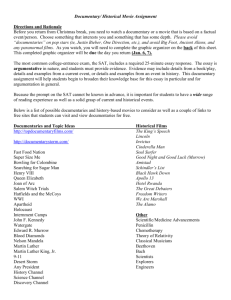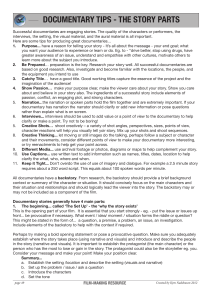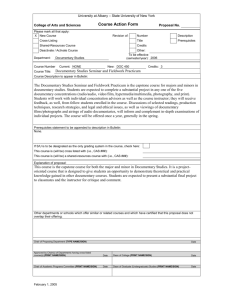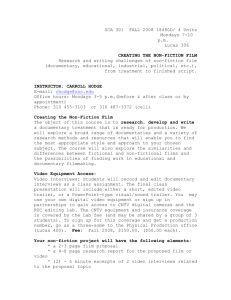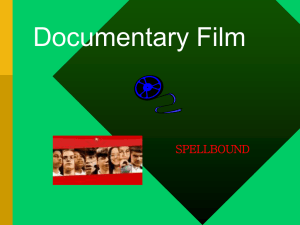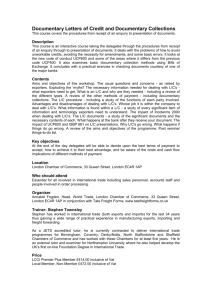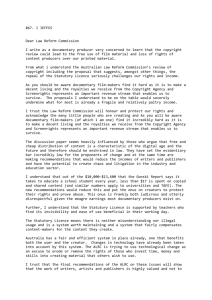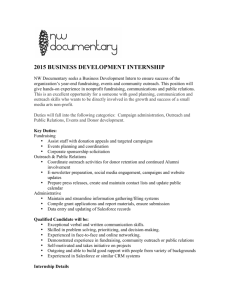Documentary Notes
advertisement
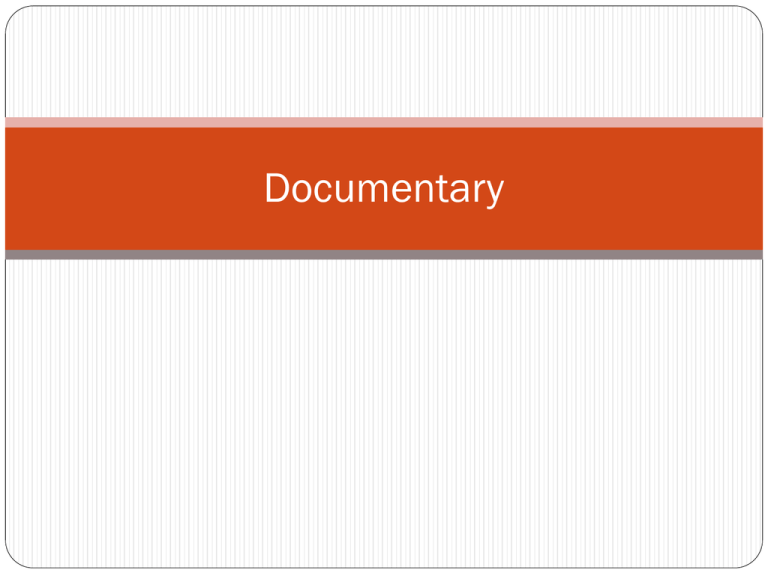
Documentary Definition and Origins Documentary—a movie that aims to inform viewers about truths or facts -term first used in 1926 by John Grierson to describe a movie called Moana about the daily life of a Polynesian youth and his family -have to go beyond strategy and organization used with typical movies such as plot and narration Questions to ask while viewing How are documentary films different from narrative ones? What attracts us to them? How do they organize their material? What makes them popular, useful, and uniquely illuminating? History Origins of documentary can be seen in political speeches, academic lectures, visual practices, paintings, diaries, letters, songs, and newspaper reports. 18th and 19th centuries saw journalism develop into a public forum for expressing ideas, announcing events and recording daily happenings 1895-1905 saw creation of actualities—moving non-fiction snapshots of real people and events Scenics—offered exotic or remarkable images of nature and foreign lands Topicals—captured and sometimes re-created historical or newsworthy events History -Robert Flaherty considered the father of documentary (1920s) His movies were anthropological and focused on nature— mostly recorded other civilizations Soviet Documentaries focused of creating strong ideological messages. After the intro of optical sound recording in 1927, documentaries took off in 30s and 40s. 30s and 40s saw a focus on politics and propaganda History Cinema verite—spontaneity and inventiveness when capturing reality, filmmakers partake and participate in the reality that they film (50s-70s) Shooting ratio—ration of footage shot to footage used; increased with the advent of video (1980s) which made filmmaking easier and less expensive -Genre of personal documentaries emerged (I.e. Supersize Me) Added funding for documentaries came from video rentals, cable and satellite TV (I.e. HBO, Discovery Channel) This is where reality TV comes from Non-fiction & Non-narrative Non-fiction films—present factual descriptions of actual events, persons, or places rather than their fictional or invented re-creation Non-narrative films—are organized in a variety of ways that eschew or de-emphasize stories and narratives, while employing other forms such as lists, repetitions, or contrasts as the organizational structure Organization Documentary organization—show or describe experience according to a certain arrangement, logic, or order different from that of narrative organization Cumulative organization—present a catalog of images or sounds throughout the course of a film Contrastive organizations—present a series of contrasts or oppositions meant to indicate different POV on its subject Developmental organizations—present places, objects, individuals, or experiences through a pattern of development with a specific non-narrative logic or structure Positions Rhetorical positions—organizational POV Explorative positions—mimic scientific POV that announce or suggest that the driving perspective of film is a search into particular social, psychological, or physical phenomena Interrogative positions—rhetorically structure a movie in either terms of an implicit or explicit question-and-answer format or other techniques that identify a subject as being under investigation Persuasive positions—articulate a perspective that expresses some other personal or social position using emotions or beliefs and aim to persuade viewers to feel and see in a certain way (I.e. An Inconvenient Truth) Roles and Purpose of Documentaries Revealing new or ignored realities Confronting assumptions Altering opinions Serving as a social, political, historical, and/or cultural lens Social Documentary—representing how people live Political Documentary—investigate and celebrate political activities Historical Documentary—concentrates of recovering and representing events or figures in history

